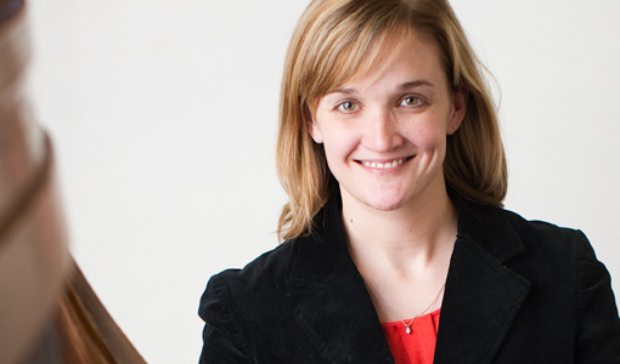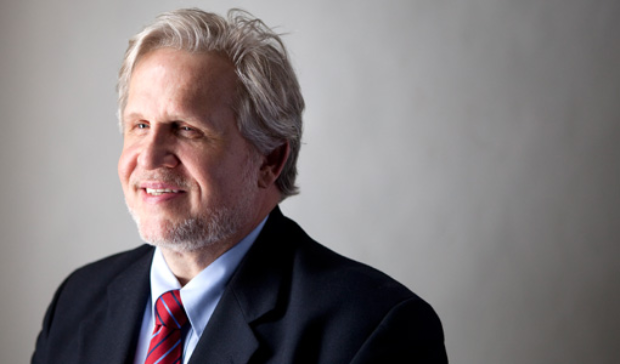Twenty-five men and women from different walks of life – some fresh out of college and some seasoned professionals – took a chance seven years ago, enrolling in a brand new, full-time MBA program at the University of St. Thomas.
The program was built from the ground up by a team of UST faculty and staff led by Dean Christopher Puto and Dr. Teresa Rothausen-Vange, professor of management at St. Thomas. And, it was this group of students that helped bring the dream of the full-time program to life. Rothausen-Vange has a special term for them: pioneers.
“The inaugural class was made up of brave souls who were willing to take a risk on this program,” said Rothausen-Vange. “They were excited and energized by the idea of being the first, of making a real impact, of getting in on the ground floor.”
She commends these students for taking a chance – for committing 21 months of concentrated study to obtain a UST MBA – and helping build a successful program for future full-time MBA students.
“Although the Full-time UST MBA program was built on the strengths of the university and its business programs, when the inaugural class got here the program only existed on paper,” Rothausen-Vange recalls. “Some of them had options for ‘already built and delivered’ alternatives or had been accepted to the top-ranked MBA programs, but they came to the University of St. Thomas because they thought what we were doing here was special – they believed in it and wanted to contribute to it.”
Pioneers from many walks of lifeMany members of this inaugural class made a leap from undergraduate education directly into the Full-time UST MBA program. Ben Beerman fell into this category; he had recently obtained his undergraduate degree from Concordia College in Moorhead, Minn., when he decided to enroll in the full-time program. He counts the energy and dedication of the faculty and leadership opportunities as what fueled his success as a student – and as a business leader.
“The UST MBA fast-forwarded my career before it started. It opened many doors that would not have been open to a recent college graduate. I felt well-prepared to begin my career,” Beerman said. Immediately following graduation, he secured a job as a senior financial analyst and currently works as a finance manager at UnitedHealth Group.
Adrienne Brown was another recent graduate, hailing from the University of Minnesota, Twin Cities. For her, the prospect of being among the first students enrolled in the Full-time UST MBA program was very compelling. “As a class of 25 students, we received individualized attention from the professors and administrators … we had the opportunity to contribute to the development of the program and obtain great leadership experience, all of which has helped me succeed in my current career,” Brown said.
After graduating from St. Thomas, Brown began working for the clinical research department at Park Nicollet. She now serves as a community clinical oncology program regulatory specialist at ParkNicollet/Methodist Hospital, where she starts and maintains research studies for the organization’s cancer research program.
Others had a few years of experience under their belts when they entered the program. Whether they came to garner the additional knowledge and skills needed to change careers paths or learn about other facets of business, they had varying years of experience to build upon.
Rich Iwen was employed as a personal banker and had worked in sales before pursuing his UST MBA. He was looking for a career change and the full-time program was the perfect fit – it was focused and timely. According to Iwen, his experience in the program helped him move out of an “unsuccessful and unrewarding sales career” into a career that he finds both challenging and rewarding. Iwen now works for Thomson Reuters as a senior marketing analyst, where he supports tactical and strategic marketing efforts by analyzing the users and usage trends of the Westlaw online legal database.
Sarah Moffitt Pike also entered the full-time program with work experience. Prior to enrolling in the program, she served as a grant writer for the City of Minneapolis. “I loved what I was doing but thought I was reaching a point where I had gotten as much as I could get out of my job. I really wanted to learn about the business side of economic development, an area I was interested in, and obtain a solid foundation of business skills,” said Moffitt Pike.
She took the knowledge gained from her experience at St. Thomas – where she focused on entrepreneurship and small business development – and started her own business fresh out of school. Moffitt Pike’s company, Open Road Adventures, created and sold travel CDs for Minnesota highways and scenic byways. She now calls this business a “hobby,” and she works full-time as a grant and contracts manager for Enterprise Development Corporation, where she focuses on co-op development.
Building communityA full-time MBA comes with many sacrifices – little free time, heavy workload, forgone income and a large tuition bill; however, according to the class of 2005, the benefits of the St. Thomas experience outweigh the costs – and have greatly impacted their careers.
Many members of the class of 2005 remark on the advantages of having a small cohort. Not only did it allow the students to develop life-long relationships with each other, but it also enabled lively discussion and deeper learning in the classroom.
Judy Winter, who currently works as a packaging specialist in marketing operations at Target Corp., counts the small class size as one of the most beneficial facets of the program. “One of my favorite aspects of the UST MBA was the opportunity to learn from my classmates’ different experiences and backgrounds. Additionally, the university’s strong emphasis on community and ethics helps differentiate my UST MBA from other MBAs,” adds Winter.
Cristina Lien, a senior financial analyst at Lawson Software, remarks that she greatly benefited from the low faculty/student ratio and the intimacy of educational relationships with core (founding) faculty and staff. “Our success was their success, and that was evident in all aspects of their relationships with our class,” said Lien.
Because of the small size of the cohort, it is no surprise that many of them still stay in touch with each other. They are connected through various social media vehicles, happy hours, networking and St. Thomas alumni events. And two alumni, Jeff Hoernemann and Joe Wilson, even work together. Both are employed by UBS Global Asset Management.
Love connections were even made. Judy Winter met her husband Nicholas while in the program, and married him four years later.
A lasting impactIn addition to forming deep relationships with other students and faculty, the class of 2005 had a wealth of leadership opportunities available to them. They were able to create everything that is typically student-run in a full-time MBA program. This includes the student association, clubs and student-to-student admissions recruiting. And this was all without the guidance of second-year students.
Matthew Horowitz, who currently works as a marketing manager for the Butter/Margarine division of Land O’Lakes, immediately took on a leadership role within the program. As the chairman of the admissions committee, he was tasked with attracting prospective students to the program; students that would help him build the legacy of the Full-time UST MBA program.
Beerman also was involved in developing the student association and multiple student groups, which enabled him to interact with faculty on a different level, as well as learn the importance of professionalism and vision.
By seizing these leadership opportunities and excelling in the classroom, it is no surprise that the members of the inaugural class have been very successful in the business world.
“A UST MBA helped me become a more polished candidate, which gave me an advantage getting in the door. From there, my problem-solving and people-skills have been vital in advancing my career,” said Michael Johnson. “The most important St. Thomas take-aways I’ve put to use are the concepts learned in the BrandMaps Marketing Simulation and HR/Management class … I feel that St. Thomas fully prepared me to apply classroom concepts in real-life situations. There is no doubt that I will continue to utilize and enhance these skills for the rest of my career.” Johnson employs the skills he learned in strategic planning, conflict and change management in his role as a project lead on a large-scale process and system implementation.
Meghan Hormann, assistant vice president of Wells Fargo Bank, says that obtaining her UST MBA has had a drastic impact on her career. She is still working for the employer for which she interned between her first and second years of school. “The door to this opportunity was opened almost solely because I was working on my MBA with a focus on entrepreneurship. I never intended on following this career path, but that was one of the great benefits of the UST MBA program – it broadened my perspective on what opportunities were available to me and what I could do with my advanced education,” she said.
The legacy lives onIt is not surprising, having gone through the trenches themselves, that these seasoned veterans have a little advice for the full-time MBA classes of 2010 and 2011 who are currently enrolled in the program.
Brown offered this: “Do what you love doing. Don’t do what you think is expected of you from your family, professors or classmates. If you find a job that you are passionate about and truly enjoy each day, success will come to you. ”
Hormann advised: “Study hard and keep your eye on the prize. Obtaining an MBA is a huge accomplishment, and all of the hard work will pay off. Somewhere along the way, someone told me that ‘the more you put into it, the more you get out of it.’ Keep that in mind when things start to seem overwhelming.”
And finally, “maintain connections, continually seek new ones, work hard and most of all, enjoy it,” suggested Beerman.
Today the program has nearly quadrupled in size – comprised of 80 students from five different continents. But although the program has grown, the legacy of the first full-time MBA class of 2005 lives on. They have set the bar high for what is expected of the students in the program and what they can accomplish. These pioneers – now highly-principled global business leaders – have fearlessly taken on the world and are already making their marks.





